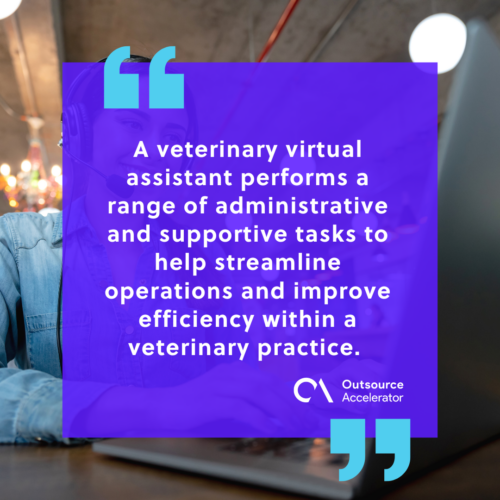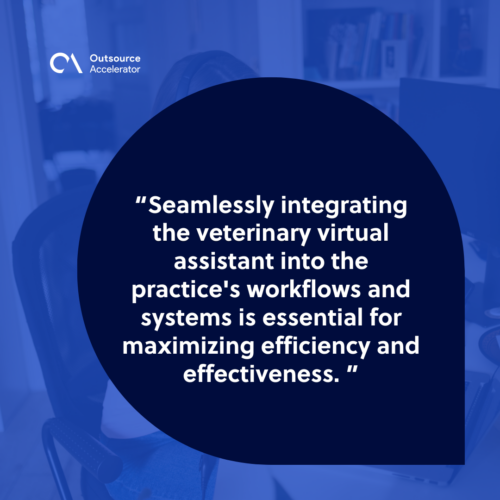Hiring veterinary virtual assistant: Challenges and best practices

Veterinary practices are increasingly exploring innovative ways to enhance efficiency and improve client care. One such innovation is the use of virtual assistants, remote professionals who can handle a wide range of administrative and client-facing tasks.
While the idea of incorporating virtual assistants into veterinary practices may seem daunting, it also presents a unique opportunity to redefine how veterinary teams operate.
Veterinary practices need to navigate the challenges of integrating these remote workers. However, they also stand to gain significant benefits that could transform the way they serve their clients and manage their daily operations.
This article examines the situation of implementing a veterinary virtual assistant.
What does a veterinary virtual assistant do?
A veterinary virtual assistant performs a range of administrative and supportive tasks to help streamline operations and improve efficiency within a veterinary practice.

Here are some tasks that a vet VA may handle:
Appointment scheduling
Virtual assistants can manage the scheduling of appointments for veterinary consultations, surgeries, vaccinations, and follow-up visits. They can coordinate with clients to find suitable time slots and make necessary arrangements.
Client communication
A veterinary virtual assistant may communicate with clients through various channels, such as phone calls, emails, and text messages.
VAs can provide information about services, answer general inquiries, and send reminders for upcoming appointments or preventive care. This approach helps build strong relationships with your clients.
Data entry and management
Virtual assistants can help organize and maintain patient records, treatment plans, medication histories, and other important information in a digital database.
They ensure that the veterinary practice’s data is accurate, up-to-date, and easily accessible.
Billing and invoicing
Vet VAs can help process billing invoices, insurance claims, and payment collections. They record financial transactions accurately and keep clients informed about their payment obligations.
Telemedicine support
Some veterinary virtual assistants may provide support for telemedicine services, facilitating remote consultations between veterinarians and pet owners.
They help schedule virtual appointments, troubleshoot technical issues, and ensure a smooth communication flow during the consultation.
Inventory management
A veterinary virtual assistant may also assist in managing the inventory of medical supplies, medications, and equipment within the veterinary practice.
They can monitor stock levels, place orders for necessary items, and keep track of expirations dates to ensure adequate supplies are always available.
Challenges of implementing a veterinary virtual assistant
Hiring a veterinary virtual assistant can come with various challenges that may need to be addressed to ensure a successful integration into the practice.
Here are some of the challenges you’ll need to overcome:
Technological barriers
One of the primary challenges of implementing a veterinary virtual assistant is overcoming technological barriers.
This includes ensuring seamless integration with existing practice management systems, electronic health records, and other technology platforms used within the practice.
Compatibility issues, data migration challenges, and cybersecurity concerns may arise during the implementation process and require careful planning and execution.
Training and adoption
Another challenge is training staff and ensuring the adoption of the virtual assistant within the practice.
Resistance to change among team members can hinder the successful onboarding of the virtual assistant. This is especially true for those who are not familiar with using technology or are accustomed to manual processes.
Proper training programs, clear communication of benefits, and ongoing support are essential to encourage staff buy-in and adoption.

Client acceptance
Client acceptance and satisfaction are crucial for the effective utilization of a veterinary virtual assistant. Some pet owners may have reservations or concerns about interacting with a virtual assistant to schedule appointments, seek information, or receive reminders.
Educating clients about the benefits of virtual assistants and addressing privacy and security concerns can help overcome client acceptance challenges. Providing alternative communication channels for those who prefer human interaction can further help.
Workflow optimization
Integrating a virtual assistant into existing practice workflows can be challenging. It’s most obvious when the veterinary virtual assistant’s capabilities do not align seamlessly with the specific needs and processes of the veterinary practice.
Customization of processes, workflow optimization, and continuous refinement based on feedback and data analytics are essential. They will ensure that the virtual assistant enhances operational efficiency rather than creating bottlenecks or inefficiencies.
Data security and privacy
Protecting sensitive patient information and ensuring compliance with data privacy regulations are critical challenges when employing a veterinary virtual assistant.
Data security measures, encryption protocols, access controls, and secure communication channels must be implemented to safeguard patient data and maintain client trust.
Best practices for managing a veterinary virtual assistant
Successfully managing a veterinary virtual assistant requires incorporating best practices that optimize performance, streamline operations, and ensure effective integration into the practice.
Here are some seven best practices for managing a veterinary virtual assistant:
1. Communicate effectively – Regular check-ins, team meetings, feedback sessions, and communication tools will help manage expectations and resolve issues promptly.
2. Train and onboard – This will ensure that they understand the practice’s workflows, software systems, protocols, and expectations.
3. Comply with data security – Implement robust data security measures, ensure encryption protocols, conduct regular security audits, and enforce strict access controls to protect sensitive information and uphold client trust.
4. Integrate workflows – Seamlessly integrating the veterinary virtual assistant into the practice’s workflows and systems is essential for maximizing efficiency and effectiveness.

5. Give feedback – Providing regular feedback, performance evaluations, and constructive criticism is essential for managing a veterinary virtual assistant effectively.
6. Monitor performance metrics – Utilize performance metrics and analytics to track the veterinary virtual assistant’s performance, identify trends, and measure progress against established goals.
7. Continuously learn and develop – Encourage ongoing learning and development for the veterinary virtual assistant to enhance their skills, knowledge, and capabilities.
Investing in a veterinary virtual assistant is a forward-thinking solution that can support the growth and success of your practice. It allows you to thrive in an increasingly demanding and competitive field.







 Independent
Independent




